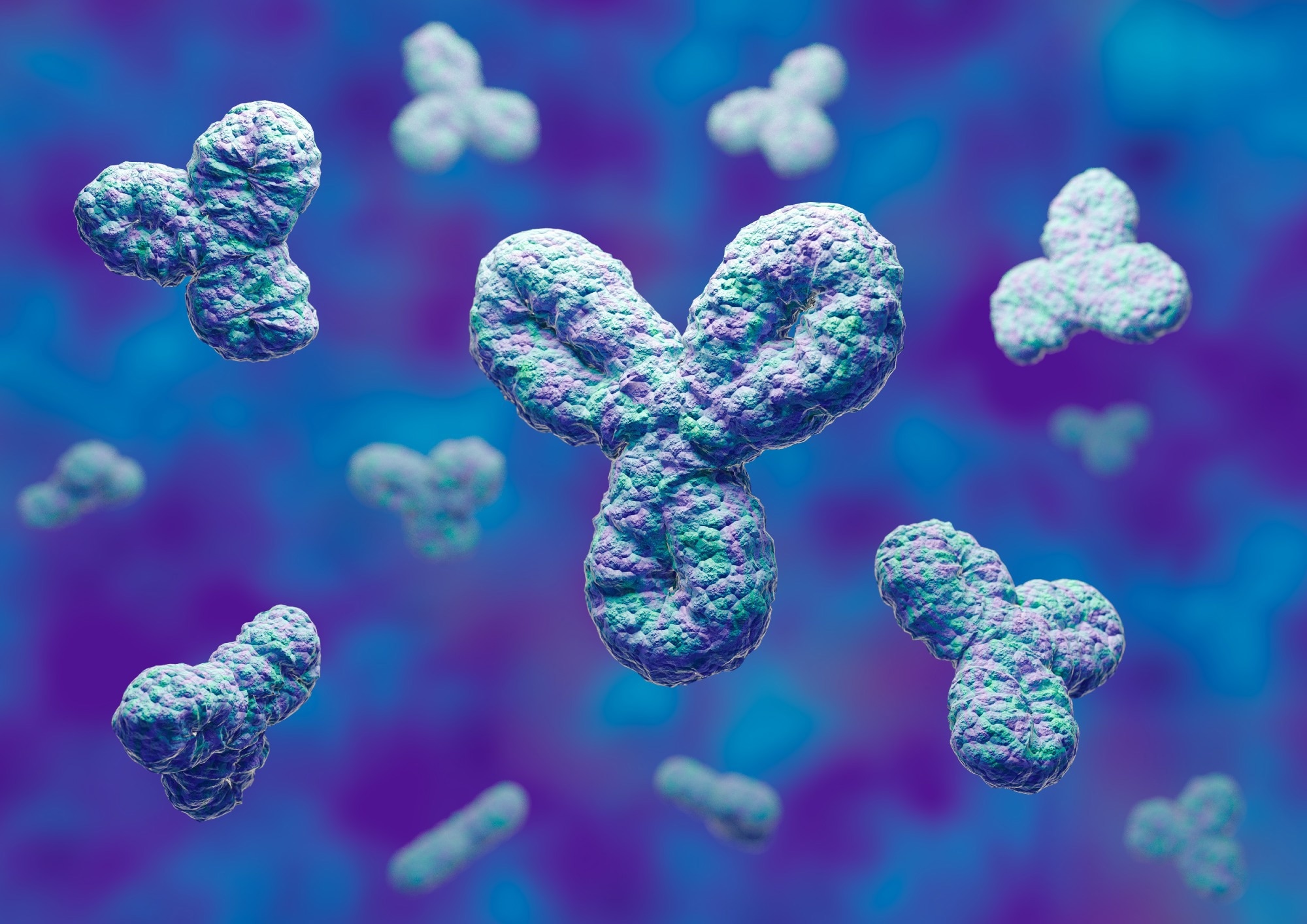In a recent study published in the Proceedings of the National Academy of Sciences, researchers developed a fully synthetic platform for nanobody generation.
 Study: Fully synthetic platform to rapidly generate tetravalent bispecific nanobody–based immunoglobulins. Image Credit: Adao / Shutterstock.com
Study: Fully synthetic platform to rapidly generate tetravalent bispecific nanobody–based immunoglobulins. Image Credit: Adao / Shutterstock.com
What are nanobodies?
Biologics have been increasingly used for the treatment or prevention of viral diseases. One of the challenges of using antibodies is the potential emergence of resistant viral variants, as exemplified by severe acute respiratory syndrome coronavirus 2 (SARS-CoV-2) variants that were fully or partially resistant to therapeutic antibodies.
Nanobodies recognize targets through a single variable heavy (VHH) domain. Nanobodies can target epitopes inaccessible to bulkier antibodies, which require variable light (VL) and heavy (VH) domains to form the paratope. Nanobodies are commonly obtained by immunizing camelids; however, yeast- and phage-based synthetic platforms have also been used for de novo discovery.
Monomeric VHH exhibits moderate neutralizing potency; however, placing hetero or homo-nanobodies in tandem can increase their potency. While the value of nanobody combinations is well known, selecting candidate nanobodies requires a priori structural information or screening of constructs for synergistic combinations.
Study findings
In the current study, researchers develop and validate a human-based nanobody library using SARS-CoV-2 as the test antigen. To this end, they created a synthetic VHH scaffold by incorporating mutations into the VH 3-23 heavy chain gene of humans. DNA encoding the nanobody was transformed into a yeast surface display vector.
Nanobodies were well displayed on the surface, with around 67% of the library showing surface display. The library was then validated using the receptor-binding domain (RBD) of the SARS-CoV-2 spike protein as the test antigen. The library was screened for RBD binders in three rounds of magnetic-activated cell sorting (MACS) and five rounds of fluorescence-activated cell sorting (FACS).
Sanger sequencing of the clones from the final FACS round revealed high library enrichment, which led to the recovery of four unique clones. These clones were expressed as His-tagged nanobodies alone or linked to the human fragment crystallizable (FC) domain to generate a nanobody fusion protein. Enzyme-linked immunosorbent assay (ELISA) verified the RBD binding of the four nanobodies.
Fc-fused nanobodies were evaluated in a SARS-CoV-2 pseudovirus neutralizing assay. The LM18 nanobody neutralized the pseudovirus with a half-maximal inhibitory concentration (IC50) of 66 nM.
Subsequently, the number of enriched nanobodies and their target RBD epitopes were determined. A yeast competition assay was used to assess epitope specificity using three SARS-CoV-2 antibodies, including CR3022 (class 4), CC12.1 (class 1), and CC6.30 (class 2).
The library was labeled with RBD and incubated with one of the three antibodies. Competitive and non-competitive populations were sorted.
After filtering, the researchers identified 123 unique nanobodies and assigned epitope bins. Of these, 100 nanobodies exhibited competitive binding with one of the antibodies, while 13 were non-competitive.
Six nanobodies competed with CC6.30 and CR3022, whereas the remaining four competed with all three antibodies. Overall, 45 nanobodies were selected for further validation. Of these, twenty-four nanobodies were binned to the class 4, CR3022-competitive epitope (Nb-C4), and 21 were binned to the class 2, CC6.30-competitive epitope (Nb-C2).
Next, the team aimed to generate bispecific tetravalent nanobody-based immunoglobulins (bsNb4-Igs) by substituting the VL and VH domains with two nanobodies targeting distinct RBD epitopes. Nanobodies were joined to the constant heavy 1 (CH1) and light (CL) domains. The bispecific constructs were based on the LM18 nanobody, given its neutralization breadth.
LM18 competed with CC12.1 and CR3022 but not with CC6.30, thus implying that class 2 nanobodies, which only compete with CC6.30, can exhibit biparatopic RBD engagement with LM18. The authors speculated that class 4 nanobodies, which only compete with CR3022, might be able to engage with LM18 concurrently.
Nanobodies with RBD-specific binding and monodisperse size-exclusion profiles were formatted into bsNb4-Ig with LM18 as the light chain and class 2/4 nanobody as the heavy chain. Thirteen of the 23 Nb-C4/LM18 bsNb4-Igs and 16 of the 20 Nb-C2/LM18 bsNb4-Igs had 10- to 470-fold improved neutralization than LM18-Fc fusion construct.
The ten most-potent bs-Nb4-Igs were assessed for neutralization of SARS-CoV-2 variant pseudoviruses. Initially, the bispecific constructs were screened for the neutralization of a pseudovirus with single L452R and E484Q point mutations. Seven bispecific constructs neutralized these mutants and were further tested against Beta, Gamma, Kappa, and Delta pseudoviruses.
Several Nb-C4/LM18 bsNb4-Igs neutralized all variant pseudoviruses with an average 50% inhibitory concentration (IC50) of 0.2 nanomolar (nM). Additionally, different bsNb4-Igs with class 2 and 4 building blocks were tested.
The Omicron variant was resistant to LM18 and all bispecific constructs with this nanobody. However, bsNb4-Igs with Nb-C4 on one arm and Nb-C2-136 on the other neutralized the Omicron variant.
Conclusions
This novel synthetic platform allows the incorporation of individual nanobodies into an IgG-like scaffold, with the resultant biparatopic constructs exhibiting neutralization equivalent to canonical antibodies. Moreover, this approach enables further affinity maturation of each building block, thereby increasing potency. This workflow applies to almost any protein target and provides a blueprint for developing multi-specific molecules.
Journal reference:
- Mindrebo, L. M., Liu, H., Ozorowski, G., et al. (2023). Fully synthetic platform to rapidly generate tetravalent bispecific nanobody–based immunoglobulins. Proceedings of the National Academy of Sciences. doi:10.1073/pnas.2216612120